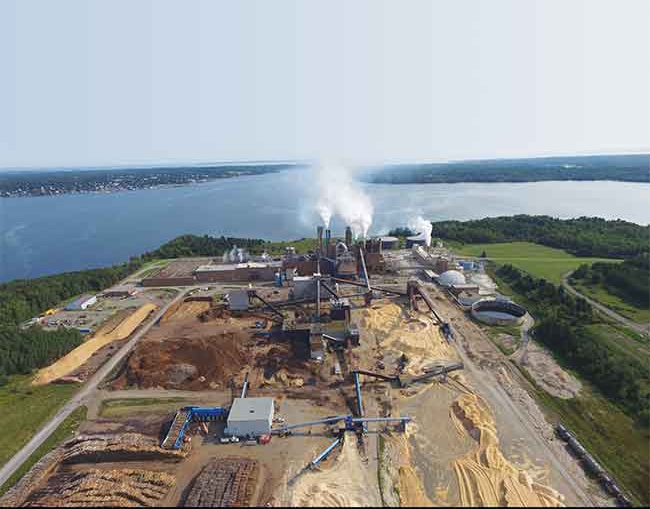
News
Pulp
Northern Pulp’s economic impact: 5 jobs for every mill employee
November 23, 2015 By Cindy Macdonald
 Northern Pulp is the largest supplier of sawlogs to Nova Scotia sawmills What’s the economic reach of one pulp mill?
Northern Pulp is the largest supplier of sawlogs to Nova Scotia sawmills What’s the economic reach of one pulp mill?What’s the economic reach of one pulp mill? Northern Pulp Nova Scotia has released results of an in-depth economic impact analysis conducted by Gardner Pinfold. The analysis finds that Northern Pulp is a significant contributor to the economy of rural Nova Scotia, creating well-paying jobs in typically high-unemployment areas. The unique partnerships between Northern Pulp and Nova Scotia sawmills, forestry contractors and private woodlot owners are a fundamental relationship for the forest industry within the province, the company states.
Northern Pulp is a kraft pulp mill, located near Abercrombie, N.S. It produces about 280,000 tonnes of pulp per year, and directly employs 339 people.
Gardner Pinfold’s analysis shows that for each employment position at the mill, five additional jobs are generated for a total of 2,040 full-time equivalent jobs created by Northern Pulp. These workers earn $101 million in income. Up to 1 in 12 Pictou County jobs are tied to Northern Pulp’s Abercrombie mill.
A supply chain of more than 1,300 companies supports the kraft pulp operation, with a total value of output of
$535 million per year.
“The challenging economic conditions for forest industries have led to mill closures in Nova Scotia and other Atlantic provinces – leaving the remaining companies even more reliant on one another. Our partnerships with sawmills, forestry contractors and private woodlot owners are critical to the success of Nova Scotia’s forest industry and to the rural economy,” said David Kerr, senior vice-president at Paper Excellence Canada, the owner of Northern Pulp.
Northern Pulp is uniquely connected with many partners in the forest industry. All of its forest management activities, including road maintenance, road construction, harvesting, trucking and silviculture, are conducted by contractor operations. “These forestry contractors provide a significant number of rural jobs across Nova Scotia and are essential partners to Northern Pulp’s success and the rural economy,” says a company statement. “Private woodlot owners and sawmills are also an important part of Northern Pulp’s supply chain.”
Jeff Bishop, executive director of the Forest Products Association of Nova Scotia agrees. “As one of the largest forest industry operations in Nova Scotia, Northern Pulp’s economic impact reaches far beyond the borders of Pictou County. Northern Pulp is a vital partner in the supply of wood fibre that keeps our entire industry moving forward every day – employing thousands of Nova Scotians.”
Pulp and sawmills are mutally beneficial
The company manages 250,000 hectares of forest land as well as a nursery where six million seedlings are grown each year. Northern Pulp is also the largest supplier of sawlogs to provincial sawmills.
In turn, the company purchases in excess of $85 million worth of wood products each year. It generates significant revenue for approximately 15 Nova Scotia sawmills through the purchase of by-product chips and bark, the analysis shows. In fact, Northern Pulp purchases more than 90 per cent of the wood chips produced in Nova Scotia, receiving, on average, 120 trucks of fibre daily.
Northern Pulp’s exports make it one of the largest shippers with the Halifax Port Authority.
The authors of the economic study looked at the direct impact of the mill, the supply of goods and services that support Northern Pulp’s mill operations, and the induced impact arising from the spending of incomes earned in direct and indirect activities.
“Northern Pulp is committed to the responsible operation of the mill by minimizing our environment impact as we produce a quality product that is made in Nova Scotia by Nova Scotians,” says Bruce Chapman, general manager of Northern Pulp Nova Scotia Corp. “With a progressive owner committed to continued investment in the mill, now is the time to leverage our strong workforce and contractors to ensure the long term sustainability of the mill.”
Print this page

